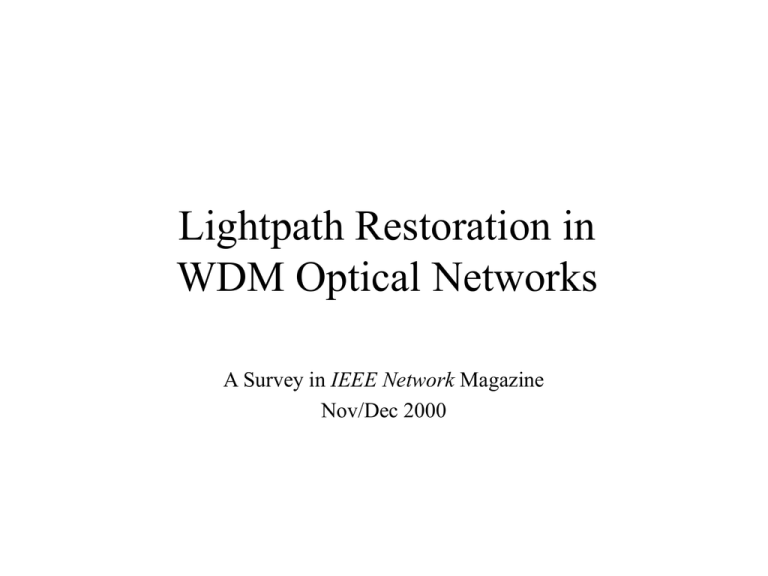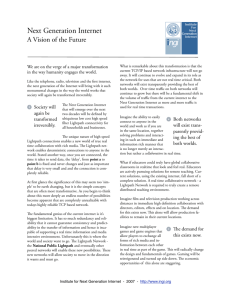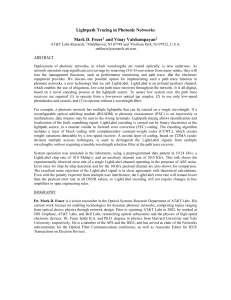Lightpath Restoration in WDM Optical Networks
advertisement

Lightpath Restoration in WDM Optical Networks A Survey in IEEE Network Magazine Nov/Dec 2000 Wavelength Division Multiplexing (WDM) • Why? To meet the challenge posed by the ever-increasing demand for bandwidth. • How? Divide the vast transmission bandwidth available on a fiber into several non-overlapping wavelength channels and enables data transmission over these channels simultaneously. • 3 layers within the transport network architecture – Physical media layer • Existing networks use WDM as a physical media layer for point-to-point transmission. • An optical signal is converted to an electrical signal, buffered, and transmitted again as an optical signal at every intermediate node before reaching the destination node. – Path layer – Circuit layer Path Layer • Also known as the optical layer. • A message is transmitted between two nodes using a lightpath without requiring any electro-optical conversion and buffering at the intermediate nodes. (wavelength routing). • A lightpath is an optical communication path between two nodes, established by allocating the same wavelength throughout the route of the transmitted data. A lightpath is uniquely identified by a wavelength and a physical path. • At the optical layer, lightpaths are established between a subset of node pairs, forming a virtual topology. • Circuit layer – Still be premature since the number of wavelengths on a fiber is restricted to a small value. Wavelength Cross-Connects (WXCs) • A WDM network consists of wavelength cross-connects (WXCs) interconnected by fiber links. • 2 Types of WXCs – Wavelength selective cross-connect (WSXC) • Route a message arriving at an incoming fiber on some wavelength to an outgoing fiber on the same wavelength. • Wavelength continuity constraint – Wavelength interchanging cross-connect (WIXC) • Wavelength conversion employed • Yield better performance • Expensive • Multifiber networks: # of wavelengths supported by one fiber is limited; but the bandwidth demands are still growing. Space Multiplexing Restoration • Why it should be fault-tolerant? – Prone to failures of components, such as links, nodes… – High volumes of traffic • Requires redundant capacity or spare resources • Restoration may be provided at the optical layer or the higher layer. • Restoration at the optical layer has several advantages: – Shorter restoration time – Efficient resource utilization – Protocol transparency • An analogy: Instead of rerouting cars off the highway onto side roads, the whole highway is instantly rerouted – intact. • The lightpath that carries traffic during normal operation is known as the primary lightpath (working lightpath, …) • When a primary lightpath fails, the traffic is rerouted over a new lightpath known as the backup lightpath (restoration lightpath, …) Restoration Schemes • What will the problem like? (Schemes) • The restoration schemes differ in their assumption about : – Functionality of cross-connects • WIXC allowed (No wavelength continuity constraint) – Traffic demand • Static/ Dynamic – Performance metric – Network control • Centralized • Distributed – Preferred for large networks – Possibility of reservation conflicts between two simultaneous attempts to find paths • How to solve it? ( Methods ) Classification of Restoration Methods Reactive / Proactive • Reactive – When an existing lightpath fails, a search is initiated to find a new lightpath which does not use the failed components. (After the failure happens) – It can not guarantee successful recovery, – Longer restoration time • Proactive – Backup lightpaths are identified and resources are reserved along the backup lightpaths at the time of establishing the primary lightpath itself. – 100 percent restoration guarantee – Faster recovery Protection vs. Restoration • In ITU-T Recommendation G.872: – Generally, protection is used for schemes where the spare capacity is reserved and dedicated to cover a specific set of failure scenarios such as in 1+1 diverse-routed protection, or path- or line-switched rings. (use pre-assigned capacity to ensure survivability) – Restoration refers to arrangements where a network-wide allocation of spare capacity is not dedicated to any specific failure but is configured as needed to restore affected carrier signals as failures arise. (reroute the affected traffic after failure occurrence by using available capacity) • Many literatures use restoration for both. • Here, use the terms proactive and reactive to mean protection and restoration, respectively. Link-based/Path-based Link-based method • local detouring: reroute traffic around the failed component • Unattractive for: – Choice of backup paths is limited – Backup paths are usually longer – Difficult in handling node failures Path-based method – end-to-end detouring: a backup lightpath is selected between the end nodes of the failed primary lightpath. Multiplexing Techniques • Dedicated backup reservation method (1+1-restored) – A dedicated backup lightpath for a primary lightpath. – Use Suurballe’s Algorithm to compute a pair of link-disjoint paths. – Shorter restoration time. (due to pre-configured WXC) – Excessive resources reserved. ( so, it is not attractive ) • Backup multiplexing – Assume single-link failure model – Suppose two primary lightpaths (disjoint) do not fail simultaneously, their backup lightpaths can share a wavelength channel. • Primary Backup Multiplexing – Used in a dynamic traffic scenario, to further improve resource utilization. – Allows a wavelength channel to be shared by a primary and one or more backup paths. – By doing so, the blocking probability of demands decreases at the expense of reduced restoration guarantee. (An increased number of lightpaths can be established) • A lightpath loses its recoverability when a channel on its backup lightpath is used by some other primary lightpath. • It regains its recoverability when the other primary lightpath terminates. Failure Dependent / Independent • Failure Dependent – Within the path-based restoration method – Associated with the failure of every link used by a primary lightpath, there is a backup lightpath. When a primary lightpath fails, the backup lightpath that corresponds to the failed link will be used. – A backup lightpath can use any link, including those used by the failed primary lightpath(working links), except the failed link. • Failure Independent – Chose a backup lightpath which is link-disjoint with the primary lightpath. – This backup path is used upon link failure, irrespective of which of its links has failed. Topics of Literatures • Lighpath Restoration for Static Traffic – Provisioning Restorable Multi-fiber Networks • ILP and Heuristic Solutions • Independent and Coordinated Design • … – Provisioning Restorable Single-fiber Networks • Wavelength Convertible Network Design • Wavelength Selective Network Design • Lightpath Restoration for Dynamic Traffic – Backup Multiplexing Based Routing – Primary-Backup Multiplexing Based Routing • Distributed Control Protocols – For Pro-active methods /Reactive methods • WDM Self-Healing Rings – Use SONET self-healing ring concepts Joint Optimization Problem • Problem Description – Given a network in terms of nodes (WXCs) and links, and a set of point-to-point demands, find both the primary lightpath and the backup lightpath for each demand so that the total required network capacity is minimized. • Relevant Situations – Existing demands on a legacy network are transferred to an optical network – Long-term planning ( using projected demands ) involves estimating capacity needs for all the demands at a time point in the future. – … • Distributed or centralized approaches • Here, a precise mathematical description, followed by an integer programming formulation Problem Formulation • Notation – N: the set of nodes; – L: the set of links; – D: the set of demands – Cij: the capacity weight for link (ij) – Wij: the capacity requirement on link (ij) in terms of # of wavelength • Objective: – Minimize – If Cij = 1 for all the links, the objective is to minimize the total number of wavelength links. – If Cij is set equal to the mileage of the link, the objective is to minimize the total wavelength miles. Integer Programming Formulation • Let F be the set of all possible (single) faults. – F = N Union L • For each f in F, let Lf be the set of links affected by f. • For each d in D, let sd and td be the source node and the destination node of demand d respectively. • We define the following variables: 1) Objective function 2) and 3) : the flow conservation constraints for demand d’s primary path and backup path, respectively. 4): Logical relationship: the backup path consumes link capacity iff the primary path is affected by the fault. 5): 6): Link capacity requirement Backup Multiplexing Restoration • Objective: To select the primary-backup lightpath pair to decrease blocking probabiltiy; to route as many restorable lightpaths as possible. • The key idea : to choose the pair that requires the minimum free wavelength channels. • A channel is free if it is used by neither any primary lightpath nor any backup lightpath. • If a wavelength channel is already used by one or more backup lightpaths, it can be used by a new backup lightpath (if allowed) at no extra cost. • Thus, the algorithm ensures that at the time of routing a new lightpath pair, the network is taken to a new state to maximize the total number of free channels in the network. Backup Multiplexing Restoration • Simple Example: Cost = 0 Backup Multiplexing Restoration • If Allowed Cost != 0






